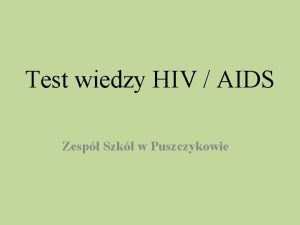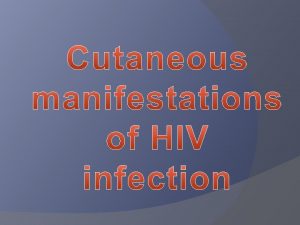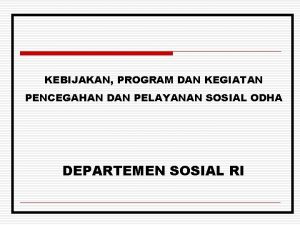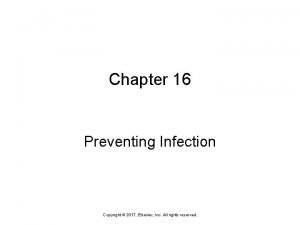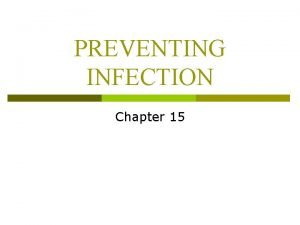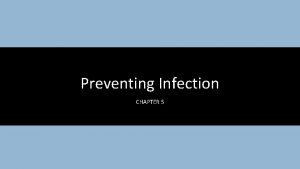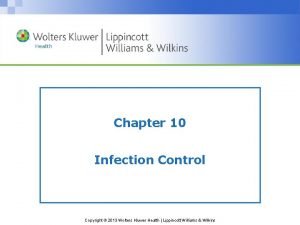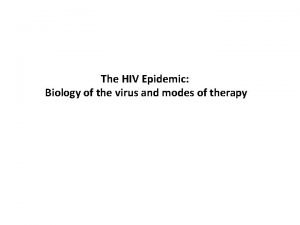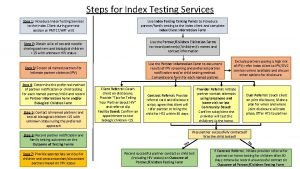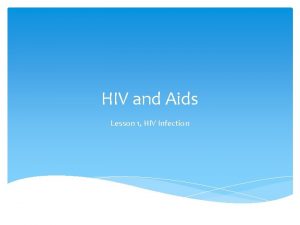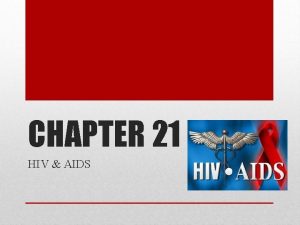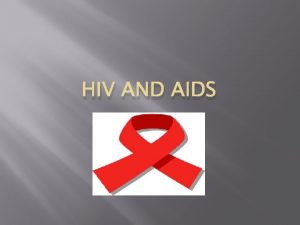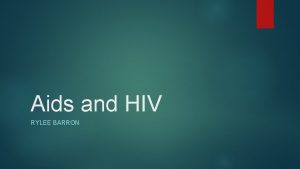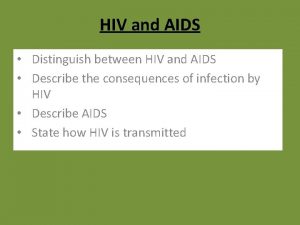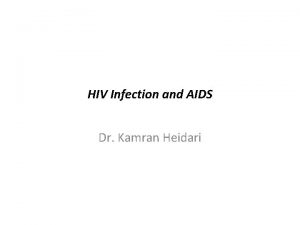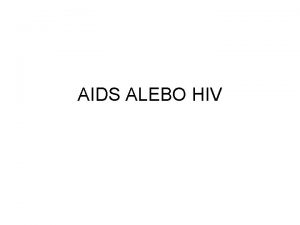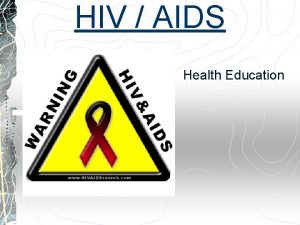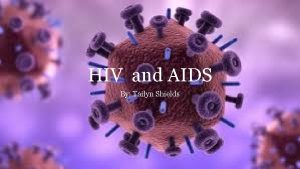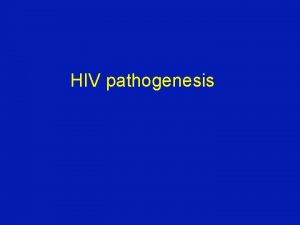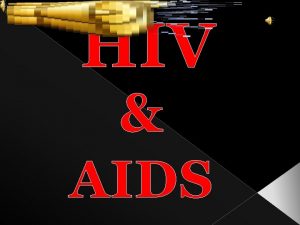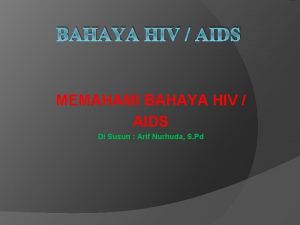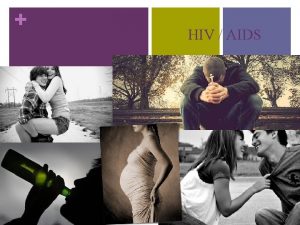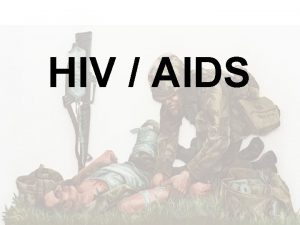Chapter 17 a HIV infection and AIDS AIDS





















- Slides: 21

Chapter 17 a HIV infection and AIDS

AIDS Pandemic • HIV/AIDS is a global epidemic • More than 36 million infected with HIV worldwide • Most infections in sub-Sahara of Africa • Increasing spread in Asia and India • Most often spread by heterosexual contact outside U. S.

HIV consists of RNA and enzymes encased in a protein coat



Immune Deficiency: AIDS • HIV targets immune T cells • Retrovirus attaches to two protein receptors (CD 4 & CCR 5) on T cells – Transmission: Body fluids, e. g. , blood, semen, breast milk, vaginal secretions – Transmission: Vaginal intercourse, anal intercourse, oral sex, breast feeding


HIV Life Cycle • Entry into T cell – HIV must bind to two proteins on surface of human cell in order to enter (infect) the cell – These proteins act as receptors for HIV – People that lack, or have mutant varieties of these protein receptors are resistant to HIV infection


HIV Life Cycle (cont) • Reverse transcriptase: copies RNA genome DNA (copy) • DNA genome (copy) nucleus integration into chromosomes • m. RNA transcription of viral proteins • Protease cuts large protein smaller proteins • Budding and self assembly


An HIV Infection Progresses to AIDS (Acquired Immune Deficiency Syndrome) • Most HIV is transmitted through sexual contact, intravenous drug use, or from a pregnant woman to her fetus • Sites of HIV infection include the immune system and the brain • An HIV infection progresses through several stages as T cell numbers decline


HIV Infection Progresses to AIDS – Phase I: few weeks to a few years; flu like symptoms, swollen lymph nodes, chills, fever, fatigue, body aches. • Virus is multiplying, antibodies are made but ineffective for complete virus removal – Phase II: within six months to 10 years; opportunistic infections present – Phase III: T cells below 200 cells/mm. , opportunistic infections and /or cancers present, clinical AIDS, death

Treatments for HIV infection are designed to block specific steps in HIV’s replication cycle • Reverse Transcriptase enzyme inhibitors: – – – – – zidovudine/Retrovir (AZT, ZDV) didanosine/Videx, Videx EC (dd. I) zalcitabine/HIVID (dd. C) stavudine/Zerit (d 4 T) lamivudine/Epivir (3 TC) abacavir/Ziagen (ABC) nevirapine/Viramune (NVP) delavirdine/Rescriptor (DLV) efavirenz/Sustiva (EFV) tenofovir DF/Viread (TDF)

Treatments for HIV infection are designed to block specific steps in HIV’s replication cycle • Protease Inhibitors – – – indinavir/Crixivan ritonavir/Norvir saquinavir/Invirase, Fortovase nelfinavir/Viracept amprenavir/Agenerase lopinavir/ritonavir, Kaletra

HIV Mutation Rate • About 1/3 of all HIV viruses produced have a mutation in the genome • Up to 1010 HIV viruses are produced person/day • Therefore, approx. 3 x 109 mutant viruses person/day are produced • High mutation rate of HIV genes and high rate of multiplication leads to virus rapidly acquiring resistance to individual drugs

Multiple Drug Therapy • Why multiple therapies work better than single therapy • Chance of mutation to resistance: – Single drug: 1 x 105 – Two drugs: 105 x 105 = 1010 – Three drugs: 105 x 105 = 1015 • Vaccine: virus mutates rapidly preventing effective vaccine production at this time

What College Students Should Know About HIV/AIDS • 1 in 500 college students are HIV positive – Statistically about 6 -10 students at FSC • 1 in 200 to 250 Massachusetts residents is infected with HIV and 7 more become infected each day • 1 in 5 people with AIDS were infected as teenagers or college students

Safer Sex • Abstinence • Limit number of sexual partners • Choose sexual partners with low risk behavior • Avoid high risk sexual partners • Use latex or polyurethane condoms or barriers • GET TESTED

 A bacterial std that usually affects mucous membranes
A bacterial std that usually affects mucous membranes Chapter 24 sexually transmitted diseases and hiv/aids
Chapter 24 sexually transmitted diseases and hiv/aids Chapter 17 oral pathology
Chapter 17 oral pathology Test wiedzy o aids z odpowiedziami
Test wiedzy o aids z odpowiedziami Causative organism of hiv/aids
Causative organism of hiv/aids Kasus hiv aids
Kasus hiv aids Puncture resistant container
Puncture resistant container Chapter 19 disease transmission and infection prevention
Chapter 19 disease transmission and infection prevention Chapter 16 infection control and standard precautions
Chapter 16 infection control and standard precautions Chapter 16 infection control and standard precautions
Chapter 16 infection control and standard precautions Chapter 19 disease transmission and infection prevention
Chapter 19 disease transmission and infection prevention Chapter 16 preventing infection
Chapter 16 preventing infection Chapter 15 infection control
Chapter 15 infection control Chapter 15:7 cleaning with an ultrasonic unit
Chapter 15:7 cleaning with an ultrasonic unit Chapter 15 preventing infection
Chapter 15 preventing infection Define infection prevention chapter 5
Define infection prevention chapter 5 Chapter 10 infection control
Chapter 10 infection control Universal precautions cosmetology
Universal precautions cosmetology Certification board of infection control and epidemiology
Certification board of infection control and epidemiology Quang trung
Quang trung Where did hiv come from
Where did hiv come from Steps of index testing
Steps of index testing



